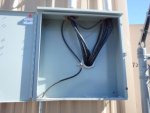xguard
Senior Member
- Location
- Baton Rouge, LA
My question is: Can a grounding electrode conductor also be used as a supply side bonding jumper?
The scenario: Service Disconnect inside a small metal building. On the outside wall direclty the otherside of the service disconnect is a service pullbox. A very short peice of conduit connects the two through the corrugated wall. Service entrace conductors along with the grounding electrode conductor pass through the short conduit. The grounding electrode conductor is connected to conduit lugs in the pull box and contiues out the box to two ground rods.
I had intended for a supply side bonding jumper to bond the conduit fittings in the box and have a separate grounding electrode conductor exit from the service disconnect, through the wall below the pull box to the ground rods.
Hopefully there is a photo attached.
Also noted, the grounding electorde conductor is not bonded on both ends to the small conduit that exits the box and goes down to the ground rods.
The scenario: Service Disconnect inside a small metal building. On the outside wall direclty the otherside of the service disconnect is a service pullbox. A very short peice of conduit connects the two through the corrugated wall. Service entrace conductors along with the grounding electrode conductor pass through the short conduit. The grounding electrode conductor is connected to conduit lugs in the pull box and contiues out the box to two ground rods.
I had intended for a supply side bonding jumper to bond the conduit fittings in the box and have a separate grounding electrode conductor exit from the service disconnect, through the wall below the pull box to the ground rods.
Hopefully there is a photo attached.
Also noted, the grounding electorde conductor is not bonded on both ends to the small conduit that exits the box and goes down to the ground rods.
Attachments
Last edited:


